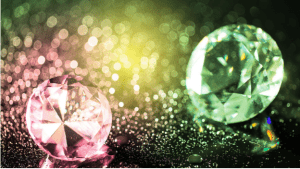The 4Cs to Consider While Buying Diamonds

When you are looking to buy diamonds, you wouldn’t want to get ripped off. Naturally, you would want the best quality diamond for the lowest price available. Thus, it is important to keep the 4Cs in mind.
The 4Cs stand for diamonds’ four qualities: carat, cut, clarity, and color. Each of these factors will affect the price of the diamond you purchase. The better grade, the higher the diamond’s price point will be.
Want to know more? Let us take a look at the 4Cs in detail.
The 4Cs in Diamond: Carat
Carat refers to the weight of the diamonds. The cost of the diamond is proportional to its weight. One carat is equal to 200 milligrams or 0.2 grams, about the same weight as a paperclip.
A single carat is divided into 100 points, so a 0.50-carat diamond would be called a “fifty-point” or “half-carat” diamond. Similarly, a 1.75-carat diamond would be called a “one and three-quarter carat” or “175-point” diamond.
It is essential to remember that two diamonds of the same carat weight can have very different prices, depending on the other three Cs. Moreover, you should not confuse carat weight with karat.
Carat is a unit of measurement for diamonds, while karat is a unit of measurement for gold purity. Thus a 20-karat gold ring contains 20 parts of gold and four parts of another metal or metal, whereas a 20-carat diamond is a much larger stone.
The 4Cs in Diamond: Cut
The cut of the diamonds determines its symmetry, proportions, and polish. It is the most important ‘C’ when it comes to diamonds. A well-cut diamond will be bright and sparkly, while a poorly-cut diamond will appear dull and lifeless. The angle, depth, and other factors affect the cut of the diamond and how well it reflects light.
The diamond cut is different from its shape. The cut is the way a diamond has been ground and polished, while the shape is the overall appearance of the diamond. For example, you can have a round-cut diamond or a pear-shaped diamond.
The diamond cuts can be broadly classified into the following categories:
-
-
Ideal Cut
-
Of all the different ways a round, brilliant diamond can be cut, only a handful meet the criteria for an “ideal” or “perfect” cut. This designation is given to diamonds cut to specific proportions, resulting in an incredibly bright stone and fire. Ideal-cut diamonds are the most expensive, as they are the rarest.
-
-
Very Good Cut
-
A very good-cut diamond is only slightly less than ideal. It still has excellent symmetry, proportions, and polish, but it does not reflect light quite as well.
-
-
Good Cut
-
A good-cut diamond is a stone that has been cut to proportions that are not quite as exacting as a very good or ideal-cut diamond. The result is a stone that is not quite as bright but still has good sparkle.
-
-
Fair Cut
-
A fair-cut diamond is a stone that has been cut to proportions that are not ideal. The result is a stone that does not have as much sparkle and may appear dull.
The 4Cs in Diamond: Clarity
The clarity of a diamond is a measure of how many blemishes or inclusions it contains. The more blemishes or inclusions, the less rare and expensive the diamond will be. One fun fact about diamonds is that all natural diamonds contain inclusions as opposed to lab-grown diamonds that are cultivated under controlled conditions, making most of them blemish-free.
-
-
Flawless (FL)
-
A flawless diamond is one that contains no blemishes or inclusions when viewed under a microscope by an experienced grader.
-
-
Internally Flawless (IF)
-
When viewed under a microscope, an internally flawless diamond contains no blemishes but may have some inclusions that are not visible to the naked eye. These diamonds are also rare and expensive.
-
-
Very, Very Slightly Included (VVS1 and VVS2)
-
Very, very slightly included diamonds have very few inclusions that are difficult for an experienced grader to see under a microscope. These inclusions are not visible to the naked eye and do not affect the diamond’s beauty.
-
-
Very Slightly Included (VS1 and VS2)
-
Very slightly included diamonds have a few inclusions that are difficult for an experienced grader to see under a microscope. These inclusions are usually not visible to the naked eye and do not affect the diamond’s beauty.
-
-
Slightly Included (SI1 and SI2)
-
Slightly included diamonds have inclusions that are visible to an experienced grader under a microscope and may be visible to the naked eye. These inclusions may affect the diamond’s brilliance and fire.
The SI grade for a diamond clarity is further divided into two: SI1 and SI2, with the latter having more visible inclusions than the former.
-
-
Included (I1, I2, and I3)
-
Included diamonds have inclusions that are visible to the naked eye and affect the diamond’s brilliance and fire. Just like the SI category, this grade is further divided into three subcategories, with I1 having fewer inclusions than I2 and I3.
The 4Cs in Diamond: Color
The color of a diamond is a measure of how little body color the stone contains. The less body color, the more rare and expensive the diamond will be. The color of diamonds is represented by using letters from D-Z, with diamonds graded D as the best among the rest.
-
-
Colorless (D-F)
-
A colorless diamond contains no body color when viewed face up. The diamonds in this scale are the rarest and most expensive diamonds.
-
-
Near Colorless (G-J)
-
A near-colorless diamond contains a small amount of body color when viewed face up. These diamonds are less rare and expensive than colorless diamonds.
-
-
Faint Colored (K-M)
-
A faint-colored diamond contains a slight yellowish tint. These diamonds are less rare and expensive than near-colorless diamonds.
-
-
Very Light Colored (N-R)
-
A very light-colored diamond contains a yellowish tint that is visible to the naked eye. These diamonds are less rare and expensive than faint-colored diamonds.
-
-
Light Colored (S-Z)
-
A light-colored diamond contains a prominent yellowish tint. These diamonds are the least rare and most affordable.
Choosing The Best Diamond For You

The choice of a diamond is a very personal one. It is important to consider all of the 4Cs when making your decision. However, you should choose the type of diamond you feel is the best for you. It is important to remember that no two diamonds are identical, so each one is truly unique.
You can choose a diamond that has a balance of all the 4Cs, or you can choose a diamond that is heavy on one particular C. It is up to you to decide what is most important to you. When you are ready to buy a diamond, be sure to work with a reputable jeweler who can help you choose the best stone for your needs.
Conclusion
We hope this blog has helped you learn about the 4Cs of diamonds. Remember, when you are ready to buy a diamond, be sure to work with a reputable jeweler who can help you choose the best stone for your needs.




